The Economics and Statistics Division maintains archives of previous publications for accountability purposes, but makes no updates to keep these documents current with the latest data revisions from Statistics Canada. As a result, information in older documents may not be accurate. Please exercise caution when referring to older documents. For the latest information and historical data, please contact the individual listed to the right.
<--- Return to Archive
For additional information relating to this article, please contact:
April 22, 2021EMPLOYMENT INSURANCE, FEBRUARY 2021 From March to September, Statistics Canada suspended publication of employment insurance (EI) statistics. Canadians were eligible for the Canada Emergency Response Benefit (CERB) during this period. New data for the period from March to September shows how an initial rise in EI claims at the start of the pandemic was reversed as new EI applicants were directed to CERB instead. After September 27, 2020 there was a temporary expansion of EI and CERB recipients were transitioned back to EI.
The new information for February was collected in reference to the period February 14-20. Prior to this period, public health restrictions were eased in many provinces. This included the reopening of non-essential businesses, cultural and recreation facilities, and in-person dining. On February 8, public health measures were eased in Quebec, Alberta, Nova Scotia and New Brunswick, while a curfew remained in effect in Quebec. Measures were eased in many regions of Ontario between February 10 and 15, but stay-at-home orders remained in place in Toronto, Peel, York and North Bay Parry Sound. Manitoba eased public health measures on February 12. In contrast, Newfoundland and Labrador went back into lockdown on February 12 amid rising cases, which required the widespread closure of non-essential businesses and services.
In February 2021, there were 45,670 Nova Scotians in receipt of regular EI (seasonally adjusted). Nova Scotia's seasonally adjusted regular EI usage increased by 2,050 (+4.7%) from January to February.
About 1.53 million Canadians received regular EI benefits in February (seasonally adjusted), an increase of 53,050 (+3.6%) from January.

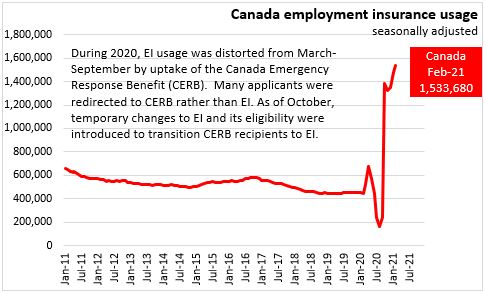
Comparing February 2021 with the same month in 2020, EI usage has more than tripled across Canada (+243.5%). In Nova Scotia, EI usage was up 79.3% over this period. The largest percentage increases in EI usage were in Ontario, followed by Quebec, British Columbia, Alberta, and Manitoba. The lowest increases in EI usage were reported in Atlantic Canada.
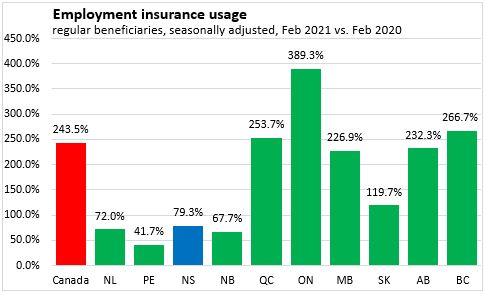
By age and sex cohort, the year over year percentage increase (Feb 2021 vs Feb 2020, seasonally adjusted) in EI usage was notably higher among women. Prior to the pandemic, women had lower EI usage compared to men. This pattern holds across all age cohorts. The industries whose employment was most affected by public health restrictions and other pandemic precautions had a disproportionate share of female employment.
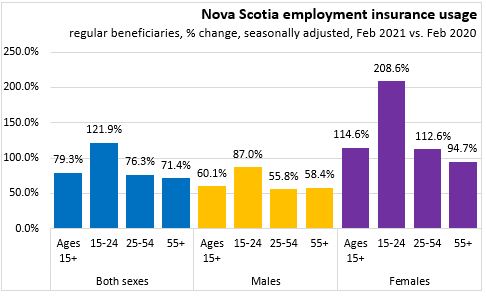
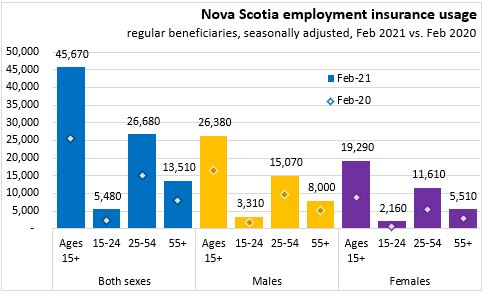
Among counties (comparing unadjusted results for Feb 2021 with Feb 2020), EI usage increased the most in Halifax, Kings, Hants, and Pictou counties. Increases in EI usage were lowest in Victoria, Inverness, and Richmond.
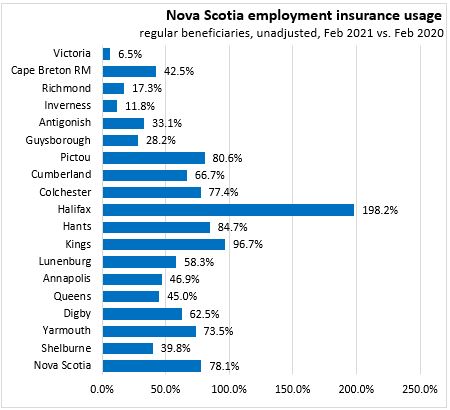
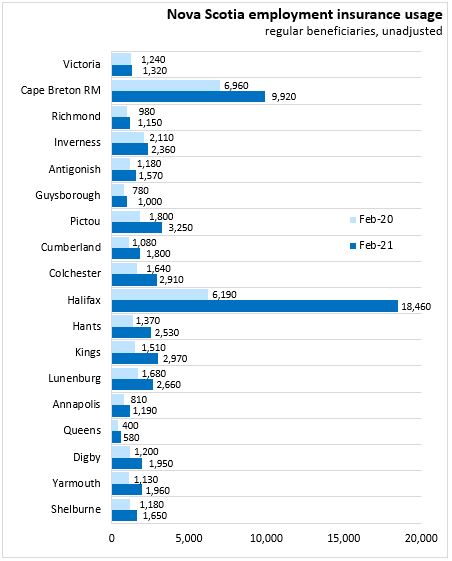
Note: Statistics Canada has not updated EI usage by occupation.
Source: Statistics Canada. Table 14-10-0011-01 Employment insurance beneficiaries (regular benefits) by province and territory, monthly, seasonally adjusted; Table 14-10-0323-01 Employment insurance beneficiaries by census division, monthly, unadjusted for seasonality
<--- Return to Archive